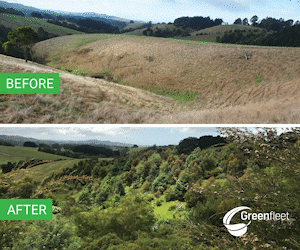It’s no garbage-fuelled Delorean, but this machine is helping Australia set a course for new vehicle emissions standards that could enlighten consumers and increase our awareness. Great Scott!
WORDS & PHOTOS SCOTT MURRAY
It doesn’t require 1.21 gigawatts to run, but research is under way in Melbourne that is set to blow the lid on new vehicle emissions reporting, the way emissions are measured and how consumers are made aware of the real-world pollution their fleets emit. No longer will it be a matter of just passing a laboratory test.
Research group ABMARC has been commissioned by the Australian Automobile Association (AAA) to conduct tests on the real-world emission performance of 30 new vehicles in Australia’s marketplace as a way of identifying and quantifying differences between on-road and lab testing. The list of vehicles includes small, medium and large passenger cars, medium/large SUVs and light commercial utes.
The objective is to provide you, fleet managers and retail consumers alike, true vehicle emission information using empirical testing protocols, and to encourage the Australian Government to test vehicles for compliance against its own regulations. Basically, the quoted emissions on a new vehicle would be from real-world on-road testing protocols, protocols developed for AAA by ABMARC and based on the European Real Driving Emissions legislation. AFMA was given exclusive access to the operation’s nerve centre.

Where were going, we need roads!
Currently, the emissions and fuel consumption measurements quoted by manufacturers for the Australian market are numbers generated from laboratory tests. In these labs, vehicles are put on a ‘chassis dyne’ and engineers measure the levels of gases emitted from the vehicle on a drive cycle that is not representative of the real world. These tests, once relatively unknown to consumers, are performed overseas and sometimes by the manufacturer. Results of these ‘test cycles’ are shown to Australian consumers through vehicle product brochures and yellow, red and/or green stickers on the passenger-side windscreen.
The benefit of the AAA program is that for those tasked with fleet procurement, large or small, they will know in more representative context what carbon monoxide, carbon dioxide, nitrogen oxide and particulate matter emissions the cars on the shopping list emit on the roads, as tested by ABMARC. Roads your staff are likely to drive en masse. This is how your company will know its true pollution and carbon footprint.
The whole program will cost half a million dollars to perform on behalf of Australian motorists, using the only portable emissions measurement system (PEMS) in Australia compliant with US EPA and European Commission standards.

This is where the magic happens, truth is revealed and the proverbial hits the fan
Natalie Roberts is the brains at the blackboard, chalking up thousands of hours studying scientific data. As managing director and principal engineer at ABMARC, Natalie together with colleague, project engineer Ben Bremner, have built what looks like their very own flux capacitor. What it really is, is about 200kg worth of scientific equipment strapped in to measure, among others, a top-selling large SUV’s emissions and fuel consumption around a carefully chosen series of roads around Melbourne, Victoria. The ‘flux capacitor’ is fitted to those 30 new vehicles and taken around the same test routes to provide an Australian benchmark.
“The ‘test cycle’ used in laboratory testing is a speed trace that carmakers have to follow, which simulates driving on a flat road,” Natalie explains of vehicle lab tests. “The cycle is the same, no undulations, no slopes, potholes, corrugations or corners and very low acceleration rates. My

Just in case this very expensive SUV goes AWOL
grandfather used to suggest: ‘When you’re driving, pretend you’ve got an egg between your foot and the throttle’ – which I think is a good description for how the laboratory drive cycle is “driven”. The truth is we don’t drive like the laboratory test in the real-world – it’s more like having a hard-
boiled egg between our feet and the throttle.” Which explains why no matter how good a driver is, they will often be unable to achieve the claimed economy stated by the manufacturer. Surprise, surprise.
In the lab tests, Natalie explains quite simply, the vehicle operates within a limited engine load and RPM range. The measurement is taken from this cycle providing an average grams of
emissions per kilometre. At the bottom of every fuel consumption sticker reads, ‘Vehicle tested in accordance with ADR 81/02. Actual fuel consumption and CO2 emissions depend on factors
such as traffic conditions, vehicle conditions and how you drive.’ However, Natalie is confident ABMARC’s research will provide far more transparency.
“In Europe they have increasingly stringent CO2 regulations placing additional pressure on manufacturers. In response, manufacturers are developing and optimising technology that works most effectively on the drive cycle and not necessarily in the real world. Over the past decade, this in conjunction with changing traffic conditions, has resulted in a growing discrepancy between

Ben goes through his pre-flight checks
laboratory results and the real world” she said. “Road and traffic conditions are constantly changing variables that affect how hard the vehicle needs to work. Unlike the official laboratory test, no road in Australia is perfectly flat and even, which means that under the laboratory testing, the vehicle is not exposed to a significant portion of its typical on road operating envelope.” For fleet budgets, this kind of information could prove extremely valuable in forecasting and reporting on running costs. Not to mention sobering.
Euro 6 regulations are the next big benchmark. Generally, pollutant levels are required to be reduced even further, with a particular emphasis on reducing particulate number. Also keep in mind greenhouse gas like methane is measured differently. The aforementioned affect our health, greenhouse gas influences global warming. Nitrogen dioxide is an irritant gas which causes inflammation of the airways and respiratory problems when commuters breathe it in waiting (and waiting) to get on the bus, or forget to recycle the a/c driving behind smokey utes, vans and other diesels. Carbon monoxide is an odourless poison gas that starves the brain and other vital organs of oxygen. That’s only a sample.

Measuring in particles per million is not for the ham-fisted
“The Joint Research Council (JRC) develops test methods for the European Commission, evaluating test equipment, establishing the test method for the real driving emissions legislation enacted for Euro 6c,” Natalie continues, offering industry background on the European emissions story. “JRC tested Euro 3, 4 and 5 cars and in measuring air quality in cities, despite increasingly tighter regulations, was not seeing any corresponding improvement in air quality. So they installed this apparatus to measure diesel and petrol cars, setting a threshold based on the lab on their results for where they expected to find harmful gas levels. All their diesel test vehicles were above the mark for NOx – however met the threshold in the laboratory.” This testing helped develop the Real Driving Emissions legislation (RDE) in Europe which will be an additional requirement for certification from 2017, meaning real-world driving conditions will formally be part of the testing process.

All is not as it seems on the showroom floor
In 2015, as the world knows, the Volkswagen Group were caught blatantly cheating on emission test cycles using software or ‘defeat devices’ that ‘knew’ when a vehicle was on the test cycle and programmed the 1.6 and 2.0-litre AE189 diesel engines to run lean on NOx emissions to pass the test. Massive marketing campaigns promoting their ‘Clean Diesels’ heightened the public’s response. Since then, the Peugeot Citroen Group have proactively conducted similar real-world emissions tests on over 30 of its own products to find roughly 40 per cent inaccuracies in emissions and fuel consumption.
Having previously worked as a calibration engineer, Natalie takes a particular professional offense to the blatancy of the German automaker. “What happened was really not acceptable, it’s one thing for a manufacturer to focus their emissions and fuel efficiency development on the legislated drive cycle, which is within the regulation, and completely another to implement a defeat device strategy.”
Measuring gaseous emissions and particulates, the accuracy level and repeatability of the system are the same as in the laboratory because it’s a portable version of the lab equipment. “The variations we may see are due to the vehicle, road and traffic conditions, not the equipment,” she explains, as that’s the point of the testing, to show variation. “We want to know the fuel consumption on a trip was 10% higher due to the conditions, not the system. The margin for accuracy is within two per cent and the repeatability is within one per cent.”
This expensive piece of gear, designed specifically to measure drivetrains, needs to be incredibly accurate. At $800,000 a pop for what looks  like a 1980s microwave, you know it’s a serious piece of kit – and an expensive Kluger too. The tolerances are so fine and the volume is extremely low, there are only three key manufacturers of this equipment in the world, specialising in powertrain emissions measurements. They also provide software to match that is so precise it’s reliable to present information for regulatory or legislative use.
like a 1980s microwave, you know it’s a serious piece of kit – and an expensive Kluger too. The tolerances are so fine and the volume is extremely low, there are only three key manufacturers of this equipment in the world, specialising in powertrain emissions measurements. They also provide software to match that is so precise it’s reliable to present information for regulatory or legislative use.

Not powered by plutonium or lightning strikes, PEMS runs on a mere fraction of that kinda power.
“If you think the equipment is complicated and technical, try having a look at the global regulations,” Natalie says, before emphasizing that they are challenging for manufacturers to meet. “We take the exhaust gas from the exhaust outlet and feed it into our exhaust extension. We make sure it’s properly sealed to prevent exhaust leaks, and wrap the extension to maintain the temperature to minimise condensation. The exhaust gas travels through the flow meter – where we’re measuring the mass of exhaust gas being expelled from the engine. Because we know the rate of emissions, using the carbon-balance equation we can calculate fuel consumption.
Further past the flow meter is the particulate probe, and then the gaseous probe. The sample lines that take the exhaust gas to the analysers are heated to 52⁰C and 191⁰C respectively.”
A Garmin GPS unit on the roof tracks the vehicle geographically and an environmental sensor measures temperature, humidity and pressure – all ambient conditions that change engine performance and must be taken into account when converting data into results. The test route must also be meticulous and precise.
“When everything’s ready to go, we hit start on the computer and set-off. We’ve developed a drive route with AAA that suits Australian conditions because European drive routes required by the legislation don’t match ours,” she said. “We’ve taken the European test requirements and adapted them to suit our conditions, such as the minimum speed requirements. For example, we don’t operate 30km/h city zones here as found in Europe. Nor would the required five minutes over 110km/h work readily in most parts of Australia whilst meeting all other test route requirements.”

A very delicate filter captures soot and goes in there…somewhere
Ben adds, “It’s also quite difficult to perform the tests because of traffic conditions and other factors which is why we conduct the test out of peak hour times.” Natalie and Ben joke that during the day in Melbourne, this is between the hours of 10.00am and 10.30am. We all know there’s nothing quite as taxing on one’s soul as getting ‘every red light’.
The European requirements also require no testing at over 30 degrees Celsius. “We haven’t run into that issue yet,” Natalie said, aware of Australia’s hottest recorded year ever quickly approaching. “It’s just not an appropriate restriction for Australia. Testing should be able to identify hot climate issues.”

Do you know your fleet’s real carbon footprint? Soon, you might.

BIG KIDS TOYS: PEMS isn’t exactly what you expect to find under the tree, but is impressive nonetheless. Lacks chrome, though.
Firing it up however is no flick of a switch or emptying of a trash can. Nor can you pinch double-As from the telly remote. “The whole system runs off powerful lithium batteries to power the system for two hours and we conduct two tests per car.” It was slightly disappointing that ‘plutonium’ or ‘garbage’ weren’t the answers to the energy question.
“A real time photo-acoustic sensor allows time resolved (second by second) PM emissions data, as the signal is calibrated to the mass of particulates on the filter. Then there’s the gaseous measurement module, for CO, CO2, NOx and hydrocarbons which is housed in a temperature controlled chamber for stability. The system uses a heated flame ionization detector for hydrocarbon measurement which requires a constant flame and fuel from a small gas bottle to keep it alight.” All these components need to be checked before a wheel is turned, and it doesn’t stop there.
“There’s a separate computer that drives the system, while an inverter box receives the DC battery power converting to AC. In total, the system takes about 90 minutes to get up to temperature and be calibrated ready for on-road tests. The vehicle is also cold-soaked overnight to prep for the cold start test,” Natalie explains.
The flux capacitor – sorry, PEMS – as well as being insanely expensive, is also as compact as it can possibly be. Regardless, it’s still about the weight of two adults; again, real-world. It takes about five hours to a day to install and is fastened securely via a series of straps and clamps to hard points inside the vehicle.
Ben takes the baton from Natalie. “You can’t just switch it on,” he states. “It’s about getting everything stable, calibrated, checking all the lines on every test, and ensuring everything’s up to temperature. There’s a lot to it because the smallest leak renders the test void.”

A thin red line of a different kind puts a number on the real emissions at cold start
Ben explains the cold start process on his laptop as he demonstrates measuring the test SUV right in front of me. The red line represents carbon dioxide – that yucky gas that your lungs hate. He clicks ‘start cycle’ for the software to begin reading from the aft exhaust probes, then turns the key. With barely a hesitation from the alternator the petrol V6 cranks into life and Ben’s program runs. A red line begins tracing across the graph as the cold motor runs higher revs to get up to operating temperature. In this ten-second interval the red line goes stratospheric, completely off the page, before coming back down as the revs drop. In the space of 30 seconds we see the science, the maths, the engineering behind a vehicle’s engine and how much pollution it emits. Seeing it on a graph puts perspective into the whole issue.
“Consumers want to know what they’re spending and polluting,” Natalie concludes.
Stickers on windscreens in showrooms that do not tell the whole story. AAA want to

Ben Bremner, ABMARC project engineer
see how vehicles measure up under a different set of parameters, namely, Aussie roads. Tram tracks, potholes, corrugations, gradual inclines, longer distances, lower speeds and hotter temperatures.
The whole scheme is not targeting manufacturers. It’s holding a light up to the emissions testing, or lack thereof, in Australia by the Australian Government. The government does not take a realistic independent measurement under any auspices of the vehicle you see on these pages. It simply relies on the laboratory test from a land far away. AAA wants this taken seriously and for ABMARC’s hard work to be adopted and put into action across our marketplace.
There’s a chance you’ll see the flux capacitor getting around town in the not-too-distant future, although minus any giant hook protruding skyward. If you do see it, give Natalie and Ben a wave as they help take our motoring industry back to the future.
If your business, organisation, local council or enterprise takes its environmental and financial footprint seriously, as it should, then showing support for this pilot campaign will only help steer your fleet down the right path.

They’ve already invented a hover board…










